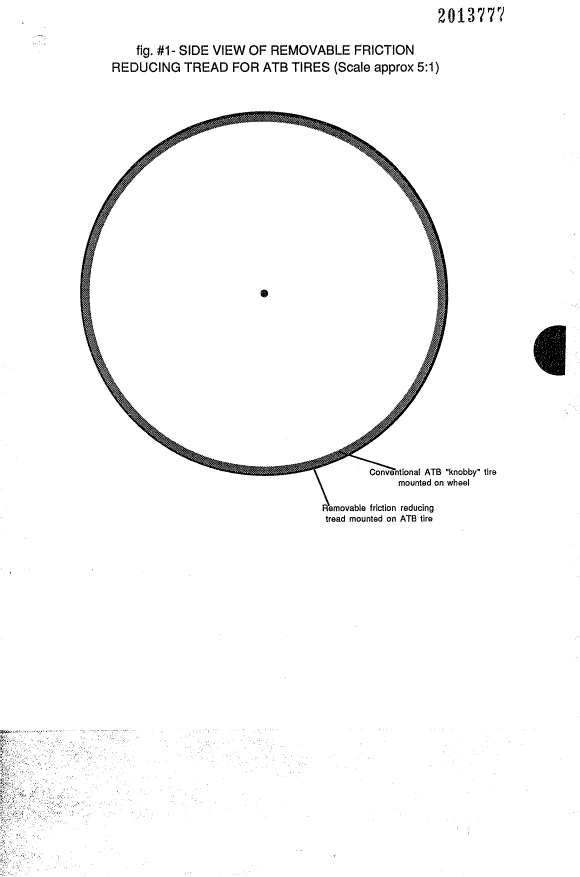Some of the information on this Web page has been provided by external sources. The Government of Canada is not responsible for the accuracy, reliability or currency of the information supplied by external sources. Users wishing to rely upon this information should consult directly with the source of the information. Content provided by external sources is not subject to official languages, privacy and accessibility requirements.
Any discrepancies in the text and image of the Claims and Abstract are due to differing posting times. Text of the Claims and Abstract are posted:
| (12) Patent Application: | (11) CA 2013777 |
|---|---|
| (54) English Title: | REMOVABLE FRICTION REDUCING TREAD FOR ALL TERRAIN BICYCLE TIRES |
| (54) French Title: | SEMELLE DE ROULEMENT REDUCTRICE DE FROTTEMENT ET AMOVIBLE POUR PNEUS DE BICYCLETTES DE MONTAGNE |
| Status: | Dead |
| (52) Canadian Patent Classification (CPC): |
|
|---|---|
| (51) International Patent Classification (IPC): |
|
| (72) Inventors : |
|
| (73) Owners : |
|
| (71) Applicants : | |
| (74) Agent: | |
| (74) Associate agent: | |
| (45) Issued: | |
| (22) Filed Date: | 1990-04-04 |
| (41) Open to Public Inspection: | 1991-10-04 |
| Availability of licence: | N/A |
| (25) Language of filing: | English |
| Patent Cooperation Treaty (PCT): | No |
|---|
| (30) Application Priority Data: | None |
|---|
ABSTRACT OF PATENT
REMOVABLE FRICTION REDUCING TREAD
FOR ALL TERRAIN BICYCLE TIRES
The tires of an all terrain bicycle (ATB) are converted from being
wide, soft and covered with knobs as required for traction in dirt
tires which are narrow, hard and smooth so as to greatly reduce the
ATBs rolling friction over pavement. Installing this invention when
appropriate allows the ATB to efficiently serve both for recreational
purposes and commuting purposes. The invention takes the form of
a removable hoop who's inside diameter is slightly smaller than the
outside diameter of a standard ATB tire. It is attached to the ATB
tire utilizing friction resulting from de-flating the ATB tire, forcing
the tread hoop onto its center and then re-inflating the tire. The
hoop itself is composed of two elements. The first is an inner band
made of steel, carbon fiber or other material having high rigidity and
tensile strength. This band provides tensile strength in the hoop,
distributes the load from the hoop onto multiple knobs on the ATB
tire and also keeps the hoop circular despite the widely spaced knobs
supporting it. The second component of the rubber hoop is the
rubber itself which forms the low friction tread and inside of which
the tensile band is encased. The rubber component is roughly semi-
circular in cross section and has the tensile band cast within it near
its slightly concave inner side. The convex outer surface of the
rubber component has a shallow road racing tread pattern cast into
it.
Note: Claims are shown in the official language in which they were submitted.
Note: Descriptions are shown in the official language in which they were submitted.

For a clearer understanding of the status of the application/patent presented on this page, the site Disclaimer , as well as the definitions for Patent , Administrative Status , Maintenance Fee and Payment History should be consulted.
| Title | Date |
|---|---|
| Forecasted Issue Date | Unavailable |
| (22) Filed | 1990-04-04 |
| (41) Open to Public Inspection | 1991-10-04 |
| Dead Application | 1992-10-05 |
There is no abandonment history.
| Fee Type | Anniversary Year | Due Date | Amount Paid | Paid Date |
|---|---|---|---|---|
| Application Fee | $0.00 | 1990-04-04 |
Note: Records showing the ownership history in alphabetical order.
| Current Owners on Record |
|---|
| KIELLAND, PETER J. |
| Past Owners on Record |
|---|
| None |